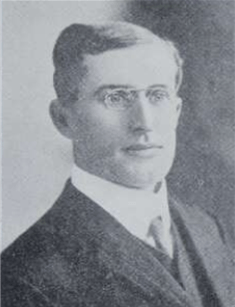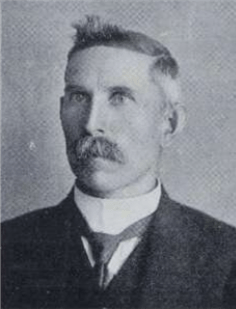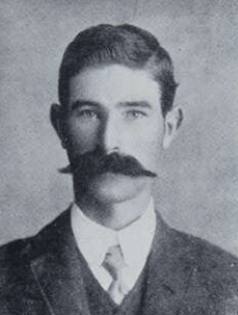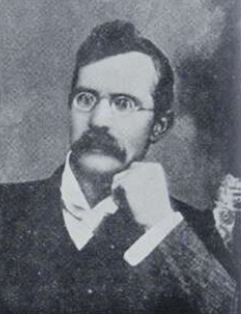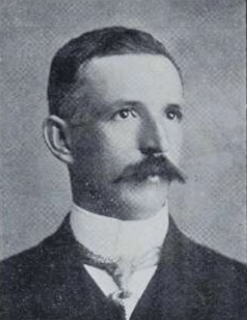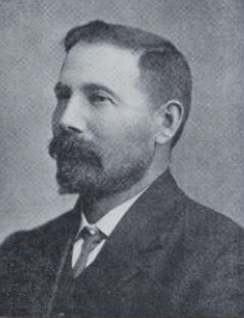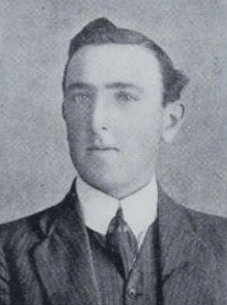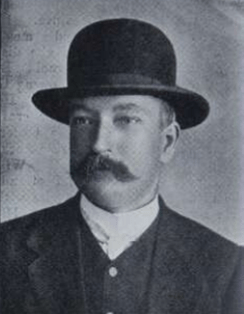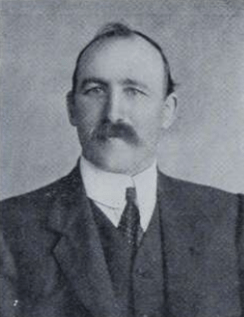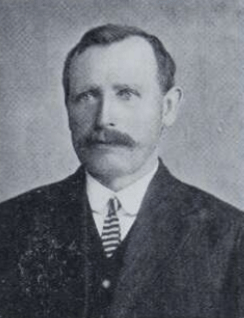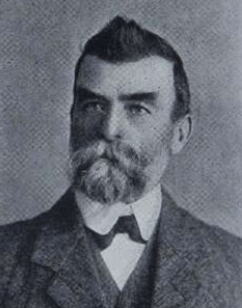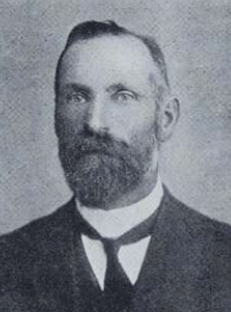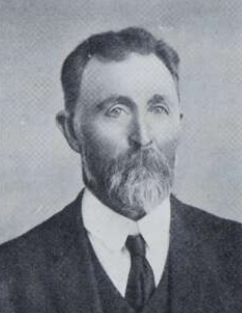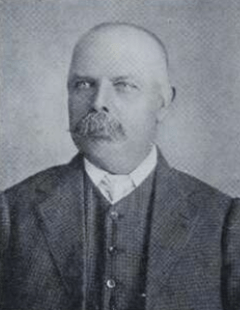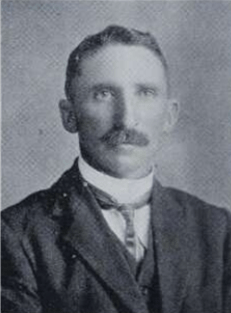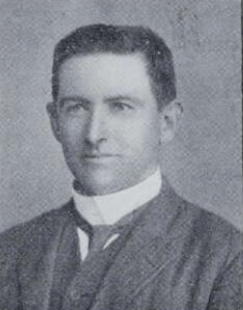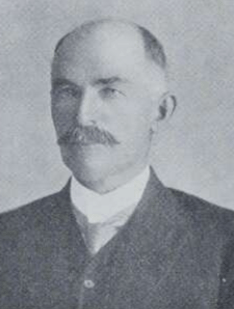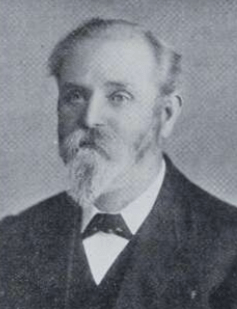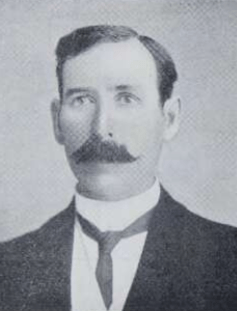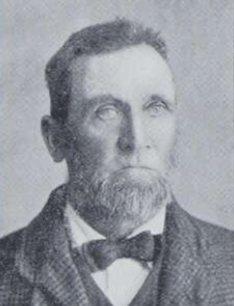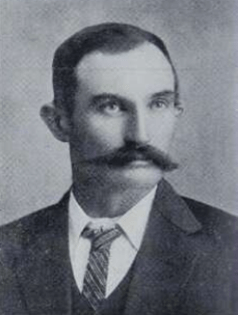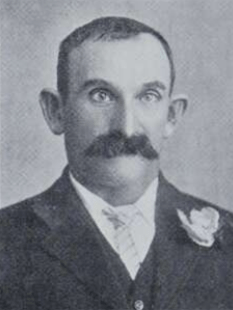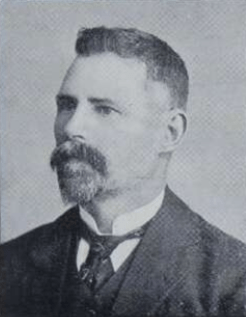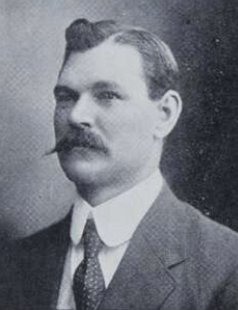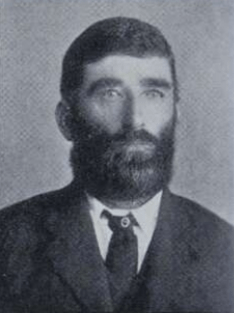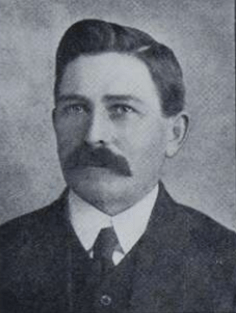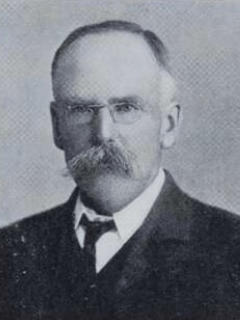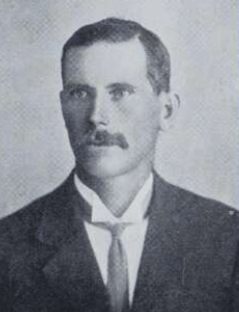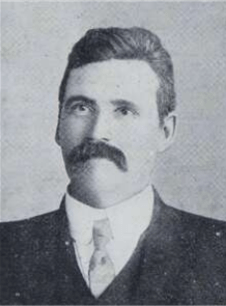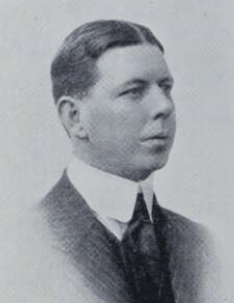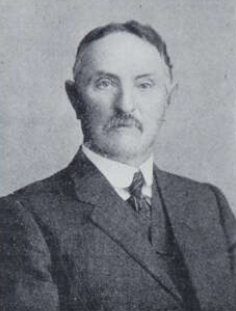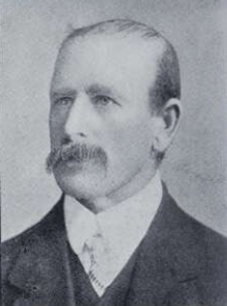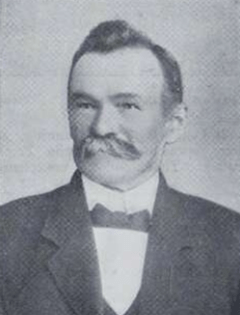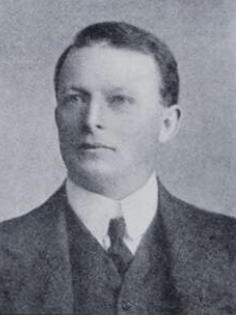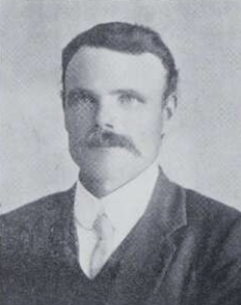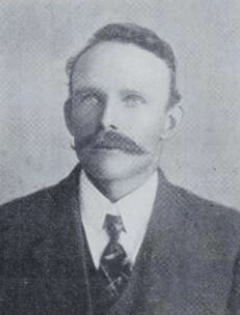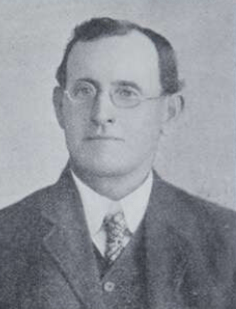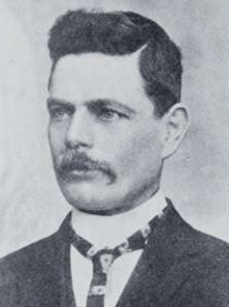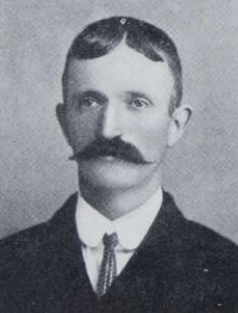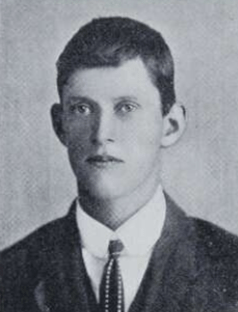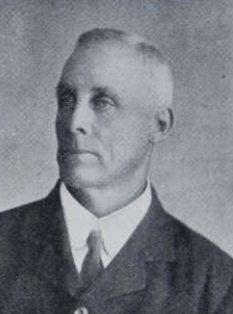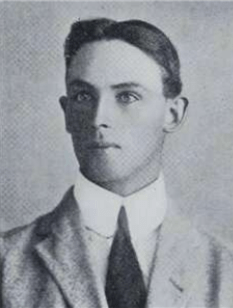Katanning People 1913.
Katanning was lucky to have a lot people with a good work ethic, a will to succeed and a “never-say-die” attitude right from the start of European settlement. But who were these people, the movers and shakers of those early days of Katanning’s development?
A two-volume tome called the “Cyclopedia of Western Australia” (Volume One – Volume Two) was commissioned by the Western Australian Government and edited by James Sykes Battye B.A., LL.B (Melb.). It was produced in 1913 and gives an overview of Western Australia and, in Volume Two, of Katanning, in 1912. The J.S. Battye Library of West Australian History is named after him.
Most of the photographs for the Katanning section of Volume Two were taken by Mr Hans Christian Biltoft, Katanning photographer of the day. His story is included below.
I have undertaken a little editing to make it in the past tense, but otherwise, it remains as produced in 1913 (ed).
Katanning People 1913. Katanning People 1913. Katanning People 1913. Katanning People 1913. Katanning People 1913. Katanning People 1913. Katanning People 1913. Katanning People 1913. Katanning People 1913.
Cyclopedia of Western Australia
An Historical and Business Review
An Epitome of Progress
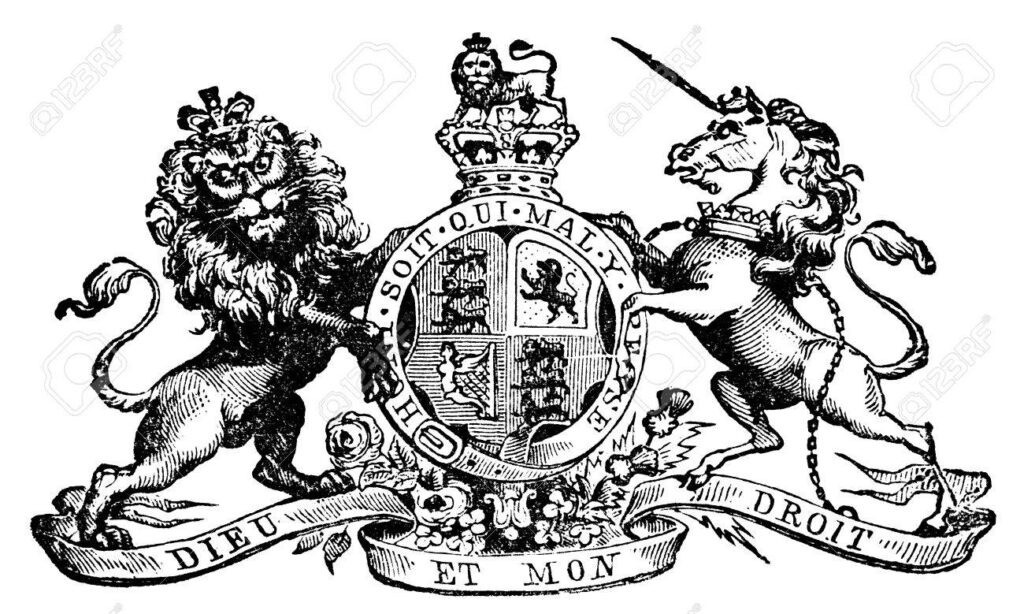
KATANNING.
Travelling along the great southern line from Wagin through Woodanilling and Moojebing, we come to Katanning, the most important town between Beverley and Albany. Situated about 225 miles from Perth, it is the chief agricultural centre along the southern railway line. The first settlement along that line took place here, and consequently the surrounding country is more extensively developed than at other centres, and the farms have larger areas under cultivation.
The land is undulating, and the soil varies considerably – from a rich chocolate loam and black sand in some parts, to a light sandy and gravelly soil in others. The timber consists of white, red, and flooded gum, with jarrah, sheoak, and stinkwood in small quantities in some localities.
Timber for building and fencing purposes is easy to obtain. The rainfall is good, the average being between 16 in. and 17 in. per annum. The country is admirably adapted for mixed farming, stock-raising, and fruit-growing, as well as for the production of grapes and for wine-making.
With all these advantages it is not surprising to find that settlement has proceeded apace, and that progress is the keynote of the district. The fertility of the soil for cereal crops is proved by the erection of a large flour mill capable of turning out 8,000 tons annually. This mill is due to the initiative of Messrs. F. and C. Piesse, who were among the pioneers of the district, being first interested in business at the Williams and Arthur Rivers and, who since the great southern line was completed, have been the principal advocates of the advantages of Katanning as a fine centre for agriculture. In addition to cereals, there is a large area under fruit-trees and vines, and a fine winery, capable of turning out nearly 18,000 gallons per annum, has been constructed. Again, the high prices obtained for the wool from the district show that as a suitable locality for the raising of sheep it can scarcely be surpassed.
The town itself, much of the progress of which is due to the faith and business capabilities of the various members of the Piesse family, contains a population of about 2,000 people. Its local government is in the hands of the Katanning Roads Board which, with the assistance of a health board, carries out the municipal functions with comparatively little administrative expense.
As befits a commercial centre of such importance four of the associated banks have branches in the town, and the business premises give evidence on every hand of stability and progress. Among the buildings of a public nature may be mentioned an up-to-date Government hospital for the district, courthouse, mechanics’ institute, and six churches. Travellers are catered for by six excellent hotels. Being lighted by electricity the town presents a modern appearance, and the great development going on all around makes it a hive of industry. The Great Southern Herald, published twice weekly, is a staunch supporter of the district and ever ready to urge its claims on every occasion.
Kojonup, situated some 26 miles to the south-west of Katanning and about 160 miles from the capital, was originally one of the old coaching stations on the main Perth-Albany Road, and is therefore one of the oldest settlements in the State. When the great southern railway took away the road traffic the town fell behind, and very little headway was made until the construction of the line from Boyanup Junction across country to Katanning. Since that time, being situated in a good agricultural area and having facilities for transport, it has made better progress. It now contains about 800 people, and stores and other buildings are gradually being erected.
A spur line of railway also runs out from Katanning to Nyabing and serves to open up and give facilities for the carriage of produce to another large area of wheat-growing country.
From this description of Katanning and its surroundings it may easily be seen that there are very few districts in the Commonwealth with better qualities to support them, and still fewer where greater evidences of a prosperous future are available.
.
Katanning People 1913. Katanning People 1913. Katanning People 1913. Katanning People 1913. Katanning People 1913. Katanning People 1913. Katanning People 1913. Katanning People 1913. Katanning People 1913.
NICHOLAS JOHN COLE TRELEAVEN
Manager of the Katanning Branch Union Bank of Australia, Limited.
Nicholas Treleaven
Nicholas Treleaven was born at Port Adelaide, South Australia, on January 7, 1870, and was a son of Mr. Nicholas Treleaven, a well-known pioneer of that State. Young Nicholas received his education at Prince Alfred College and, at eighteen years of age, joined the staff of the Bank of South Australia at its head office at Adelaide. In 1892 he resigned from the service in order to transfer to that of the Union Bank of Australia, Limited and, after four years’ connection with the Adelaide Branch received promotion to the General Manager’s Department in Melbourne.
Shortly afterwards Mr. Treleaven was transferred to the Inspectors’ Division for Victoria, South Australia, and Tasmania and, subsequently for six years, filled the position of relieving manager in South Australia and Victoria. About the end of 1904 he received appointment to the permanent position of manager and came to Western Australia to open a branch of the Union Bank at Katanning which, up to 1913, he had continued to control.
Apart from his official duties Mr. Treleaven was largely interested in landed property near Broome Hill, where he owned an estate of 2,500 acres, highly improved, where mixed farming operations were carried on with considerable success. On the property were 1,000 acres under tillage and a fine flock of sheep in numbers running well into four figures.
Mr. Treleaven enjoyed outdoor recreation in chiefly the game of tennis, but if opportunity offered, he would drive to his estate where wide scope for healthy exercise was always available. He was married in 1904 to Muriel, daughter of Mr. Thomas Curson, works manager of the Central Mine, Broken Hill, New South Wales, and, up to 1913, they had one daughter.
.
WILLIAM JOHN ROGERS J.P.
General Merchant, Katanning
William John Rogers
William Rogers was a son of Mr. John Rogers, of Colchester, Essex, England, where William was born on June 4, 1862. He received his education at the public school in his native town and, when fourteen years of age, became apprenticed to the hardware trade for five years.
At the conclusion of his indentures, he left Colchester for London. During ten years spent in there he passed through every department of the trade, gaining much valuable experience. In 1890 Mr. Rogers came to Australia with the intention of settling in Victoria, but at Adelaide was offered a position in the firm of McLean Brothers & Rigg.
He continued his voyage to Melbourne only to find on arrival a considerable depression in commercial circles owing to a maritime strike. He returned to South Australia and for the next twelve months was in the service of the above-mentioned firm. He then accepted an offer from the firm of Barnett & Company, of Albany, Western Australia, with whom he remained for a number of years.
In 1901 he decided to launch out for himself and purchased the business formerly carried on by Mr. C. A. Harris at Katanning, which he conducted with considerable success. In order to supply his clients with the best class of goods, Mr. Rogers imported largely from the Old Country, and his stock was always being replenished with fresh consignments of up-to-date and seasonable goods. In 1911 the business was formed into a limited company, the shareholders consisting of Mr Rogers, his two sons, and a Mr. W. Hessen, who for some years previously had filled the office of accountant.
Mr. Rogers devoted a portion of his time to the public interest and, in 1910, was gazetted a Justice of the Peace by the Moore Government. For some time, he occupied a seat on the committee of the local agricultural society. He took a deep interest in the advancement of the Baptist Church and was treasurer of that body for some years. He was a member of the Masonic craft and held office in the Grand Lodge of Western Australia.
Before his departure from England, he married Hannah Mary, daughter of Mr. John Pinkerton, of Edinburgh, Scotland, and had two sons and five daughters. More
.
JOHN GERRANS
Postmaster, Katanning.
John Gerrans was born on December 7, 1873, in Jamieson, Victoria, the son of Mr. Richard Gerrans. He was educated in Jamieson, pursuing his scholastic studies chiefly in the evening at a night school conducted by a Mr. Ullrich and, at fourteen years of age, joined the Civil Service as messenger in the Postal Department at Jamieson.
After remaining there for nearly six years, during which period he became a proficient operator, he was transferred to Yarraville, near Melbourne, and shortly afterwards resigned from the service in order to come to Western Australia. He immediately obtained a position as operator in the head office of the State Postal Department at Perth and, rapidly receiving promotion, was sent to Coolgardie where he spent six months.
From there he was further promoted to the charge of Niagara Post Office, and held this position for six years, being the first officer appointed at that centre and the first Civil Servant in Western Australia to hold an appointment north of Menzies. At the outbreak of the Kookynie goldfield he was sent to open an office there and remained in charge for five years, leaving in 1906 to enter upon the duties of the more important position at Katanning.
In all places where he has resided, Mr. Gerrans cordially identified himself with all public movements for the welfare of the community when unrestricted by the regulations of his office.
In his younger days he was a keen sportsman, all forms of clean sport claiming him as a hearty advocate. He later became keenly interested in rifle shooting and acted as hon. Treasurer of the local club, a position he held for some years. A member of the Masonic fraternity, he attained to various honours in the craft, and several years was Master of Lodge No. 30, Katanning, W.A.C.
In 1902 Mr. Gerrans married Selma, daughter of Mr. Henry Bliss, of Williamstown, Victoria, and had two sons and a daughter.
.
JOHN FERDINAND WANKE
General Storekeeper, Katanning.
John Ferdinand Wanke
The eldest son of Mr. C. F. Wanke, John Ferdinand Wanke was born at Mannum, on the River Murray, South Australia, on July 4, 1884. At fifteen years of age, he left the State school, where he finished his education after seven years at a German academy and learnt the blacksmithing trade. This he abandoned after two years and, in 1900, came with his parents to Western Australia, where land was taken up by the family in the Katanning district. Tiring of work on the farm Mr. Wanke turned his attention to business pursuits, taking a position in the firm of W. J. Rogers, a Katanning storekeeper.
After seven years with the firm Mr. Wanke purchased a decadent business and applied his energies to the task of bringing it into line with the most successful commercial concerns in the district. These efforts rewarded him with most satisfactory results and, in the years of his taking over the business, the store turnover increased greatly to become a very healthy operation. At the commencement of the business the assistance of a younger brother was sufficient to meet the demands of the business. But as the business continued to flourish six people were kept busily employed and his delivery extended over a radius of 40 miles from Katanning.
Mr. Wanke identified himself with the various institutions of the town and was conductor of the choir in connection with the Baptist Church, of which he was also a deacon. He was a member of the Masonic fraternity, and acted as organist of the local lodge. He took an active interest in the affairs of the Independent Order of Rechabites and held the office of District Levite of the Order.
In 1908 he married Florence Emily, daughter of Mr. G. H. Todd, now of Katanning, who came originally from York, England, and for a time settled in Victoria. He has one daughter. More
.
OLIVER ANDREW CALDWELL
2 September 1874 – 20 October 1956
Farmer – Gidgelbarrup Farm – Badgebup
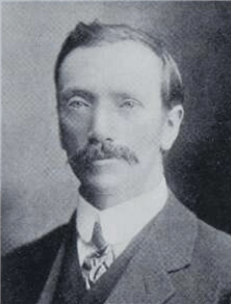
Oliver Caldwell was the son of Robert Caldwell who was a member of the South Australian parliament for twenty one years. He was educated at the Woodside State School and, at 16 years of age, he proceeded to Mount Gambier where he gained employment on Hon. George Riddochs pastoral estate and continued there for several years.
In 1898 Oliver came to Western Australia in company with John Warren of “Dyliabing”, whom he had assisted in the early development of his property, and two years later launched out on his own. His selection of 2,000 acres of land in the Badgebup district was, in the first instance, a joint venture with his brother who some years later sold his interest in the property.
Oliver retained 1,180 acres applied chiefly to agricultural purposes with 600 acres under cultivation of cereals and 300 merino sheep. He bred Clydesdale horses and had twenty horses working in the fields. At the time he also had a small apiary and sold the honey. More
.
CHARLES ARTHUR HARRIS.
Farmers’ Agent, Katanning.
Charles Arthur Harris
Charles Harris was born at Loughton, Essex, England, on September 1, 1868, a son of Mr. Martin Harris. He was educated in Loughton town and, when fourteen years of age, began his apprenticeship to the bakery and confectionery trade under Mr. George Mills, Royal baker, of Chelmsford, with whom he remained for eight years.
In 1890, after a subsequent period at Bournemouth, where he occupied a position as cashier in a store, Mr. Harris came to Western Australia and, “carrying his swag” from Perth to Albany, was successful in securing a position as confectioner there. Shortly afterwards, however, he gave this up to move to Katanning, where for a year, he was in the employ of Messrs. F. and C. Piesse, taking charge of the bake-house in connection with their business.
He next established a bakery business on his own account and conducted it successfully for over twelve years, adding various other departments as opportunity occurred. These included the purveying of dairy produce and groceries and, as his operations expanded, it demanded more commodious premises. He erected a large building which had the distinction of being the first two-storied store in the district.
Mr. Harris subsequently disposed of his business and entered farming pursuits, having previously taken up land in the district, but was eventually compelled to part with this property on account of failing health. He then established himself at Katanning in his agency business, which he continued successfully from that time.
In 1909, Mr. Harris was elected a member of the roads board of the district, succeeding Mr. Arnold E. Piesse, who had resigned owing to pressing parliamentary claims. He is a member of the Masonic craft and held office in this Order.
In 1891, he married Catherine Jackson, daughter of Mr. William Leggat, of Glasgow, Scotland, who died in 1902, leaving him with three sons and two daughters. His present wife, whom he married in 1903, is a sister of the late Mrs. Harris. More
.
SCOTT & SCOTT.
Accountants and Auditors.
The firm of Scott & Scott (William J. Scott and Arthur Scott.), which carried on business as auctioneers, accountants and auditors, land, machinery, and general agents, was first established in Katanning in 1903, when the town was yet in its infancy. By the energy and push of the promoters it kept pace with the rapid development of the district.
It had made its influence felt over a wide area and became a household name among settlers in a radius of many miles of the town. Mr. William J. Scott, to whom is due the credit of having built up the business in the first instance, was a native of Tasmania, where he was born on July 29, 1875. At the close of his scholastic education
he had some banking experience which has proved of great value in his subsequent career. In 1903, attracted from the island by glowing reports of commercial activity in Western Australia, he set sail for this State, and travelling directly to Katanning immediately secured business premises.
With his brother, Mr. Arthur Scott being joint proprietor in the enterprise, the firm opened up operations under the name of Scott & Scott. Beginning as commission agents, it gradually extended its scope with the various departments of the business developing in accordance with the demands of the growing population.
The land-agency branch was carried on in conjunction with the similar class of business conducted by Mr. A. Scott, at Northam, Kellerberrin, and Meckering and, by this arrangement, capital opportunities were presented to those desirous of purchasing or disposing of properties.
The firm represented a large number of important companies, including George Wills and Co.; the International Harvester Company, agricultural machinery; Buffalo Pitts Company, traction and portable engines and “Niagara” threshers; Clarence H. Smith (Ardrossan, South Australia), ploughs, cultivators, scoops, etc.; English superphosphates and English Thomas’ phosphates (“Globe” brand); and all farmers’ requisites.
Having worked up the business to a high standard of efficiency and established it on a sound financial basis, Mr. W. J. Scott, in 1908, accepted an appointment with the firm of Messrs. George Wills & Co. For the management of the Katanning business, he secured the services of Mr. J. A. Carr who, prior to the above date, had been employed with the Northam branch of Scott & Scott for about three years.
Mr. Scott was noted for his interest in the affairs of the neighbourhood where he has spent many successful years. He ranked foremost among the riflemen of the district, and won the championship and other trophies in connection with the Katanning Rifle Club, of which he was a foundation member.
.
Mr. JOHN AUGUSTINE CARR.
Scott & Scott, Katanning.
Mr John Augustine Carr
John Carr was born at Christ church, New Zealand, on October 25, 1877, and received his education at the Marist Brothers’ College in that city. He had a long connection with commercial life, and rapidly obtained a grip of Mr. Scott’s methods in the conduct of the business at Katanning. Following in the footsteps of his principal, and adopting his progressive policy, he proved his ability to cope with the growing trade and, under his control, the forward movement inaugurated at the foundation of the business continued without any setbacks.
.
ALEXANDER THOMSON.
Builder & Contractor.
Mr Alexander Thomson
Alex Thomson was born of Scottish parents at South Shields, England, on March 9, 1872. Immigrating with his family to Victoria during his early boyhood he attended the Essendon State school until attaining the age of fourteen, when he was apprenticed to the carpentering trade under his father.
In 1905, after moving to Katanning, he achieved conspicuous success in the erection of the Royal Exchange Hotel. This work was followed by the mechanics’ institute, the railway station buildings, churches, and private residences, in addition to three large hotels and other buildings in Albany and the surrounding districts. Mr. Thomson had various investments in building properties in the district and, in many ways, had become well-known with the neighbourhood and town where he had made his home. More More
.
MICHAEL FRANCIS SKELTON
General Draper, Katanning.
Mr Michael Francis Skelton
Michael Skelton was born at Dublin, Ireland, on September 4, 1888, a son of Henry Thomas Skelton of Dublin. Coming to Australia with his mother while still quite a child, he received his education at the Christian Brothers’ College in Perth and, concluding his scholastic career at the age of sixteen, became employed in the drapery business with the firm of Robertson & Moffat in the city, where he obtained a good general insight into the trade.
Leaving this establishment he turned his attention to other pursuits but, returning to his former line of work, became employed in the wholesale trade in the warehouse of Messrs. Beath, Schiess, & Co., of Murray Street, Perth. He remained with this firm for some considerable time, during which he gained valuable experience in wholesale dealing. Subsequently, he augmented his knowledge of the retail business first in Charles Moore & Co.’s establishment in Hay Street and, at a later date, joining the staff of the Economic Store. During the greater part of his two years there he was the only country representative of the firm.
In 1911, Mr. Skelton launched out on his own account by opening a business on Austral Terrace, Katanning, commanding a large share of the patronage of the district. Mr. Skelton was prominent in the H.A.C.B.S. and was honorary secretary of the Katanning branch of that organisation. He also took a live interest in the Young Australian League and worked with energy for the promotion of the ends and aims of this worthy cause.
He was a keen advocate for all that is clean and healthy in the world of sport and occupied leading official positions in several of the local clubs, football perhaps having had the premier place in his interest.
.
WILLIAM EARNEST BEVILAQUA.
Commission Agent, Katanning.
Mr William Earnest Bevilaqua
The son of Mr. Louis Bevilaqua, of Adelaide, South Australia, William was born at Lyndoch Valley on July 27, 1871. He received his education at Prince Alfred College, in the capital. Upon the completion of his scholastic career, he entered the Adelaide Branch of the Commercial Bank of Australia, Limited, and continued in this position until the institution was closed.
In 1898 he visited Western Australia and, being attracted by bush life, spent several years in trapping kangaroos and wild dogs, meeting with considerable success. In 1903 he returned to South Australia, but after a year back there the “call of the west” brought him back. More
.
CHRISTIAN FREDERICK MITTER.
Newsagent and Stationer.
Christian Frederick Mitter
Christian Mitter was born at Bendigo, Victoria, on November 21, 1876, where his father, (also Mr. Christian Frederick Mitter) coach-builder, was a resident. Having concluded his education at the Bendigo Grammar School Mr. Mitter, at the age of seventeen, was apprenticed to the engineering branch of Messrs. J. Horwood & Sons, of the Bendigo Ironwork’s. He continued with this firm for nine years, during which period he passed through all branches of practical engineering, giving due attention also to the theoretical side of the profession. More
.
HANS CHRISTIAN BILTOFT.
Photographer.
Hans Christian Biltoft
Danish by birth, Hans Biltoft was born at Varde, in Denmark, on February 12, 1864. He commenced his education at a public school in his native town and subsequently attended a private college for two years. At the conclusion of his studies, he became engaged in seafaring pursuits for six years. Relinquishing marine life in the early eighties, he learned the art and business of photography in Denmark and, in 1886, came to Australia, landing at Sydney, New South Wales.
He then took up orchard work in the fruit-growing districts of that State. Having spent several years in this calling he went to the Peak Hill gold diggings, where he met with varied success in alluvial mining. Three years later, in 1893, he formed one of the group which discovered payable gold at Fifield, New South Wales, and was granted a reward claim by the Government. The group met with a fair measure of success before Mr. Biltoft was authorised by a Sydney syndicate to proceed to Western Australia to prospect in the vicinity of the newly discovered eastern goldfields. Here, however, he was not so fortunate. Having worked for some time without much result he directed his steps to the alluvial field at Clermont, in Queensland, and spent three successful years in this district.
In 1899, he abandoned the precarious search for the precious metal and again turned his attention to his former art of photography as a means of livelihood. Returning to Kalgoorlie in the following year he established himself as a photographer there with both indoor and outdoor photography for the Press and in studio work.
In 1910 Mr. Biltoft moved to Katanning and carried on in the same line. In addition to his photographic business he owned a farm at Badgebup comprising 1,000 acres.
He interested himself in the rifle club movement in the district and occupied a seat on the committee of that body. He was also well known in church matters, being a vestryman of the Church of England in Katanning.
In 1894 Mr. Biltoft married Amy Sophia, daughter of Mr. Frederick Alexander Martyn, of Moonan Brook, New South Wales and, in 1913, he had two sons and two daughters.
.
WALTER PANGBOURNE BIRD.
Tailor and Mercer.
Walter Bird opened in business in 1909 and had personally conducted operations from that time. In March, 1911, he established a branch business at Wagin. Mr. Bird was born at Wangaratta, Victoria, on May 11, 1878, the fourth son of Frederick Augustus Bird, of Benalla, Victoria.
Leaving school in his early teens he became apprenticed to the tailoring trade in Benalla. In 1897, having completed his indentures, he migrated to Albany, Western Australia, where he took a junior position, a year later continuing his travels to Kalgoorlie. After being employed in several establishments he joined Mr. P. S. Jane in a business partnership which extended over a couple of years, but was dissolved on account of a depression in trade which settled on the goldfields.
Subsequently Mr. Bird determined to launch out for himself, and coming to Katanning, established himself in business. After only a short period of residence in the town he had met with considerable success. In addition to his business pursuits, he took a keen interest in the various organisations of the town. Music, both vocal and instrumental, was his forte, and his fine bass voice made him an acquisition in all social gatherings. He was also conductor of the choir in connection with the local Methodist Church where he rendered valuable service to the community. He was also a member of the Masonic craft in which he held various office and, in earlier days, he was well known in the realms of cricket and football.
In 1905 Mr. Bird married Alice Emma, daughter of Mr. W. Gunter, of Katanning, late of Kalgoorlie, Western Australia, and prior to that of Quorn, South Australia, and, in 1913 had two sons and one daughter.
.
JAMES FAIRCLOUGH
Federal Hotel.
James Fairclough, a son of Mr. Mervin Fairclough, of Adelaide, South Australia, was born on June 7, 1862. He received his education at Mount Barker under Rev. Jenkins and, at fifteen years of age, was apprenticed to the butchering trade at an establishment conducted by Mr. Tonkin, of Adelaide.
Having completed his indentures he proceeded to Broken Hill in the early days of the mining industry and gained an intimate knowledge of the processes of silver-mining during his employment with the South and South Extended mines, eventually attaining a position as mine manager, which he held for six years.
In 1892 he arrived in Western Australia and proceeded from Albany to Narrogin and walked to Kalgoorlie via Southern Cross where for some time he was employed in the development of the famous Bayley’s Reward claim. At Coolgardie he was employed on the Ivanhoe Mine, Boulder, and in the course of time was promoted to the post of shift manager under the Captain Kitto. After two years he was offered the position of under-ground manager of Fraser’s South Extended at Southern Cross, and subsequently found further scope for his abilities in the management of the Richmond Gem Mine at Mount Malcolm in 1905-6.
In 1907 he relinquished connection with the mining industry, and purchased the lease of the Federal Hotel, Katanning, which was popular throughout the district.
Mr. Fairclough, from his arrival in Western Australia, had always been a supporter and patron of the turf, and served as committeeman of the various racing clubs in the towns where he had resided. For three years he acted as president of the Katanning Racing Club. He made the love of horses his hobby, and owned many successful performers, among which “Ranji” and “Mainsheet” had distinguished themselves in the ring.
Mr. Fairclough was also a keen supporter of athletics and was president of the local football association and other clubs of the district. He was a member of the Masonic fraternity and held office in the craft. Married in 1898 to Susan Jane, daughter of Mr. John Bennett, of Bendigo, Victoria, he had two sons in 1913. More
.
CHARLES FERDINAND WANKE, J.P.
Katanning.
Mr Charles Ferdinand Wanke JP
Charles Wanke, a son of Mr. Albin Ferdinand Wanke, one of the first German colonists of South Australia, was born at Lobethal, in that State, on September 25, 1857. He received his education at a private school in his native town and was subsequently employed in the machinery trade for five years.
At the termination of that period, he opened in business on his own account at Quorn in 1878, and later moved to Mannum, on the River Murray, where he continued for twenty years before retiring on account of ill-health.
In 1900 he came to Western Australia and purchased a property formerly owned by a Mr. Andrew and situated about five miles from Katanning. It was comprised of 2,000 acres, and carried good crops of wheat and oats, and special attention was given to the breeding of merino sheep, the flock numbering about 1,200. More
.
WILLIAM MILSOM BAKER.
Katanning.
William Baker was a son of George Edward Baker, of Kaniva, Victoria. He was born at Modbury in South Australia on November 13, 1867 and, at the close of his education at the local school, served his apprenticeship to the butchering trade in Yongala. Having completed his indentures, he went to Victoria and became engaged in farming pursuits in conjunction with his father in the Wimmera district.
In 1896, he left the eastern states and, upon arrival in Western Australia, returned to his former calling, taking a position as journeyman in the establishment of Mr. E. L. Holley, at Katanning. More
.
WILLIAM PEMBLE, J.P.
Grazier, Katanning.
Mr William Pemble JP
William Pemble was a son of Mr. Henry Pemble. of Sussex, England, latterly of Ballan, Victoria, and was born in September 1860. His education begun in Ballan and was concluded at Watervale Grammar School, South Australia. At twenty-three years of age, he became a wheat agent in South Australia on behalf of the firm of W. R. Cave & Co., of Adelaide, a position he filled for three years.
Beckoned by the bright prospects held out by the gold discoveries in the Kimberley region of Western Australia, Mr. Pemble “followed the gleam” as far as Albany in March 1885. However, his intention to proceed changed with the offer of an appointment of under-manager on the stations owned by Messrs. Hassell Brothers. He decided to accept the offer and, for five years, he carried out these duties, finally determining to launch out for himself. More
.
ISAAC MILLS, J.P.
Farmer and Grazier, Katanning.
Isaac Mills JP
Isaac Mills was born at Nairne, South Australia, on August 4, 1850. Receiving some primary instruction in his native town, he continued his education at a later date at Charleston, under a Mr. Disher. Upon leaving school he was first employed on the home farm with his father, Mr. George Mills, being one of South Australia’s pioneers, who landed at Port Adelaide by the ship “Somersetshire” in 1839. Subsequently Mr. Mills joined the Kanmantoo Copper Mine and, in conjunction with fifteen partners, became personally involved in its development.
Finding the life uncongenial he once more turned his attention to agriculture. He took up 779 acres of Crown land in the Hawker district, 300 miles north of Adelaide and, for nine years, endeavoured to win a fair return for his capital and labour. He finally abandoned this enterprise on account of the uncertainty of the rainfall. He then purchased a farm near Kadina, on the Yorke Peninsula.
Mr. Mills, during the fifteen years that he continued in that district, became well-known through being involved with many public and charitable movements. He held various offices, among which was that of chairman of the Ninnes District Council, which he resigned on the eve of his departure for Western Australia in 1904.
In February of that year, he arrived in the Katanning district which he had visited in the previous year. On that occasion he had selected four properties of nearly 4,000 acres of land for himself and his sons at Yellanup. In addition to these farms, which were devoted chiefly to the growing of cereals, Mr. Mills also owned a holding of 800 acres at Lake Ewlyamartup, nine miles east of Katanning.
He was soon pressed into public service and, for seven years, had been a member of the Katanning Roads Board, and for six years a committeeman of the Great Southern Agricultural Society. He was also a committeeman of the Katanning Cemetery Board and chairman of the Katanning-Nampup Railway League, having the satisfaction of seeing that line accomplished. Special credit was due to Mr. Mills for the part he played in bringing about the construction of this railway, which had been much needed in the district.
He was trustee of the Methodist Church in Katanning and, on four occasions, represented this Church at the Methodist Annual Conference held in Perth. He was a member of the Oddfellows’ Order for over forty-two years having been connected with the Manchester Unity, and also held membership in the Orange organisation.
In 1870 Mr. Mills married Catherine, daughter of Edward Gartrell, of Nairne, South Australia, and had five sons and five daughters.
.
TOM GARSTONE, J.P.
“Martling” Farm, Katanning.
Mr Tom Garstone JP
Tom Garstone was a son of Thomas Garstone of Haywood Forest, Herefordshire, England, and was born near the city of Hereford, on March 16, 1866. He pursued his scholastic education at Clehonger in his native county and, until eighteen years of age, assisted in looking after the game preserves of the Belmont Estate in Herefordshire. More
.
CYRIL RICHARD GARSTONE
Cyril Richard Garstone was born in Katanning in 1894, the second of of five children, to Tom and Ellen Garstone (nee Wilcox). Cyril married Ida Mary Day and they had three children; Eric Jack Garstone, Beulah Louise Ellen Griffiths (nee Garstone) and Tom Garstone.
Cyril Garstone enlisted during World War One on 9 November, 1915 returning to Australia on 8 January, 1919 after serving in the 43rd Battalion. He passed away in Katanning on 4 June, 1972 and his wife Ida died on 21 February, 1964.
He was the brother of Clarence Davies Garstone; May Evelyn Ladyman; Doris Irene Conning and Thomas Gilbert Garstone. More
.
THOMAS WILLIAM LANGLEY
Agriculturist and Grazier,
“Minnawarra.”
Mr Thomas William Langley
Thomas Langley was a son Mr. Joseph W. Langley, of Loddon, Norfolk, England, and was born in London on December 19, 1872. He was educated at a private school attached to the Church of England at Brixton and, at sixteen years of age, having completed his scholastic course, joined his brother in farming pursuits in the Mittagong district of New South Wales.
During his four years there he gained an intimate knowledge of the conditions of his new country in relation to the agricultural industry. Upon turning 21 he abandoned that calling and, coming to Western Australia, turned his attention to the aerated mineral waters manufacture in Perth, in partnership with Mr. T. Tracy. He later sold his interests to his brother-in-law, Mr. J. J. Wallis and spent four years at Katanning.
Here he purchased a similar concern established in the first place by Messrs. F. & C. Piesse, adding to it a general commission agency business. Upon receiving an offer from F & C Piesse & Co of the management of the metropolitan branch of its business Mr. Langley sold out and, shortly after taking control in Perth, was instrumental in floating the produce and auctioneering branch of the concern into a limited liability company called Piesse, Lowe, & Co., Limited, of which he remained in charge until a change in the personnel took place by the retirement of the Hon. F. H. Piesse.
He then actively interested himself in the formation of the Producers’ Markets, Limited, which embraced the business of Piesse, Lowe, & Co., Perth, and the Producers’ Union Sale rooms, retaining separately as his own interest the Kalgoorlie branch of the business of Piesse, Lowe, & Co., of which he remained managing director.
Returning to Katanning in 1907 Mr. Langley floated the business of A. E. Piesse & Co. into a limited company which, as the Katanning Stock and Trading Co., had a very large clientele and was one of the most important among similar concerns along the great southern line. Mr. Langley combined the duties of manager of this company with various other posts of a financial and honorary nature and, in addition to his mercantile interests, had a large stake in the agricultural industry. He owned over 4,000 acres of well-developed land and, in 1913, held over 1,300 acres under crop. This was the largest area, by hundreds of acres, tilled by any one owner in the district. In addition to this extensive cultivation of wheat and oats the estate carried about 2,500 sheep, which proved very profitable.
Mr. Langley’s wide experience was invaluable to new settlers, and he was always ready with the timely word of counsel to such. There were few public positions of prominence in the district which he had not filled with credit to himself and benefit to the community. The agricultural society, in particular, he filled the position of hon. Secretary for many years, with the result that it held the prestige in the State second only to that of the Royal Agricultural Show in Perth. He was president or vice-president of nearly all the sporting clubs, particularly with outdoor recreation and athletics generally, and, in 1911, he was elected president of the Katanning District Polo Association. He also served a lengthy period on the committee of the local mechanics’ institute.
His homestead, which was built in bungalow style, contained eleven rooms with French doors opening on to the wide verandahs which encircle the house, which is surrounded by a fine garden and orchard. The outhouses included two cottages for employees and an engine-house with a six-horsepower Marshall steam engine providing power for chaff cutting, threshing, sawing timber, etc.
In 1900, Mr Langley married Henrietta Maude, daughter of Mr. John Rogers, of Northcote, Victoria and, in 1913, he had two sons.
.
JOHN JOSEPH HOLLAND, J.P., M.B. (Syd.)
Medical Practitioner.
Dr John Joseph Holland
A son of Mr. Daniel Holland, a merchant of Goulburn, New South Wales, John Joseph Holland was born on February 11, 1876. He received his preliminary education at St. Joseph’s College, Hunter’s Hill, Sydney, and upon matriculating at the University of Sydney was awarded the Norbert-Quirk Scholarship at St. John’s College for classics.
He entered upon the study of medicine and surgery, qualifying at that institution in 1904 and, upon gaining his diplomas, his first position was at St. Vincent’s Hospital, Sydney. Here he obtained valuable experience as house surgeon. This position was followed by that of resident medical officer at the Coast Hospital, Sydney, and he subsequently entered in the same capacity the Lewisham Hospital for women and children. More
.
CHARLES EDWARD SEWELL, LL.B.
Barrister and Solicitor.
Charles Sewell was a son of John Sewell, of Surrey, England, where Charles was born on September 1, 1859. When about seven years old he accompanied his father to Australia and was educated chiefly by a tutor in his own home until he reached the standard necessary to qualify him for admission to the University of Adelaide, where he matriculated and subsequently graduated in law.
He was articled to Mr (later Sir John) Gordon, of South Australia and, having completed his indentures, was called to the Bar of South Australia in 1886. Eventually he was taken into partnership by his former principal and, shortly afterwards, purchased the practice, which he carried on for five years.
At the end of this period, he was induced to go to Victoria and, having been admitted to practice there in 1891, proceeded to Mildura and then to Bendigo and, at a later date, was identified with the mining district of Eaglehawk.
Owing to the bursting of the now notorious land boom in Victoria and the consequent depression of trade, Mr. Sewell decided to accept an invitation to come to Western Australia, where the prosperity resultant upon the outbreak of the eastern goldfields had attracted experts in every profession. His extensive knowledge of mining law endowed him with special fitness for practice on the fields. He spent his six months of probation after arrival in managing the business of Messrs. Mann & Sinclair at Menzies, receiving admission to the Western Australian Bar in 1897.
An attack of fever, however, compelled him to relinquish his connection with the mining centre and, proceeding to Albany, he established a practice which he carried on for five years. When the mail steamers ceased to call at that port Mr. Sewell moved to Fremantle but becoming a sufferer from severe muscular rheumatism found it necessary to take up his residence at some inland district. For this purpose, he made the choice of Katanning and settled here in January 1911.
Mr. Sewell was a member of the Masonic craft, in which he held various principal offices. He was twice married, and has one son by the first marriage.
.
JOHN COLLIN COOK
Hotel Proprietor
John Cook was a son of John Cook, of Suffolk, England, and was born in that county on January 8, 1864. He received his education at a private school at Wickham Brook, in Suffolk and upon the conclusion of his studies at sixteen years of age began business life in the green-grocery trade at Liverpool for about three years. He then obtained a position on the north-eastern railway and, having gone through the preliminary training, undertook the responsible duties of engine driver. He continued in this post until his departure for Western Australia in 1887.
Upon arrival Mr. Cook found employment on the railway line then in course of construction between Albany and Beverley, subsequently transferring his services to the Western Australian Land Company. He was chosen to drive the first through train from Albany to Beverley. Leaving the railway service in 1894, he purchased the lease of the Katanning Hotel, Katanning, and conducted that house for nearly five years. He later became the proprietor of the Exchange Hotel, which he carried on for a similar period.
Upon relinquishing this enterprise he entered upon the development of a farm of 600 acres which he had taken up some time previously in the district of Katanning, and for several years continued to work this property successfully. An orchard of 20 acres in extent and mixed farming operations generally absorbing the whole of his time and attention.
At the beginning of 1911 Mr. Cook sold his farm and orchard and took his family for an extended trip, during which they travelled throughout Great Britain, Ireland, and the Continent. In 1884 he married Mary Ann, daughter of Mr. Thomas Rowlands, of West Hartlepool, County Durham, England, and had two sons and one daughter. More
.
PATRICK STUART, J.P.
Secretary and Engineer
Katanning Roads Board.
Mr Patrick Stuart
Born at Coulfetrim, near Ballycastle, County Antrim, Ireland, on March 18, 1861, Patrick Stuart was a son of farmer Mr. Andrew Stuart. He was educated at the National School in his native town, subsequently completing his education at St. Patrick’s, Dublin.
He left at the age of eighteen in order to emigrate to New Zealand where he became engaged in the teaching profession, filling the position of headmaster of the Roman Catholic school at Ross, on the west coast of the South Island. In 1891, after ten years there, the reports of gold discoveries in Western Australia drew him to this State. Upon arriving in Perth, he obtained a position in the office of the late Mr. C. Y. O’Connor, then Engineer-in-Chief for the State.
For six years Mr. Stuart worked under the Master of Engineering, at the end of which period he was offered the position of town clerk and engineer of Menzies, which he accepted. He continued to fill this office for about seven years, resigning in 1903 to take up similar duties at Leederville. A call from the Murchison district next led him to accept the appointment of town clerk at Day Dawn, in which he continued until 1908 when he moved to Katanning. Mr. Stuart had the distinction of being the oldest officer in the State, still in harness, appointed under the Local Government Act.
Outside his official duties he found time to support various public movements and took a deep interest in the Fresh-air League, that admirable institution on the goldfields set up to protect and promote the health and physical welfare of children. He acted as secretary to the Menzies Hospital for some time and occupied a similar post in connection with the Katanning Public Hospital.
He was one of the leading rifle shots of the State and was a founder of one of the first rifle clubs in Western Australia, being closely involved with the movement from its inception. He was winner of the first gold medal for 1,000 yards in Association Competition, and was the possessor of several other trophies, in addition to handsome presentations from the various clubs in which he had been involved in. Mr. Stuart was secretary of the Day Dawn Turf Club and chairman of the Menzies Racing Club. His appointment of Justice of the Peace was made by the Forrest Administration in the early nineties.
In 1894 he married Mary, daughter of Mr. Patrick Healy, of the West Coast of New Zealand, and had two sons and three daughters.
.
ARTHUR JOSEPH WATTS.
D.D.S., Royal College of Surgeons
Ireland (1881)
Dr. Arthur Joseph Watts
Arthur Watts was a member of the Dental Society of Western Australia; member of the Dental Board, Western Australia (1905); Examiner Dental Surgery and Pathology and Dental Mechanics, Dental Board, Western Australia (1906-8); and Curator of the Dental Laboratory, Dental Hospital, London.
He was born at Deanston, Perthshire, Scotland, on May 26, 1856, a son of Martin Watts who was well known in the cotton industry in Scotland. He was educated at the Model Free Grammar School, Macclesfield, Cheshire, England, and pursued his professional studies under several masters, being articled to the prominent dental practitioner of the time, Mr. Sydney Wormald, of Stockport, England. More
.
FRANK MARSHALL GARE, J.P.
Katanning Stock and Trading
Company Limited.
Mr. Frank Marshall Gare
A native of South Australia, Frank Gare was born at Kanmantoo, near Mount Barker, on April 2, 1866. His father, Mr. Edward B. Gare, was well known in that State at the time. He pursued his studies in various places, eventually completing his scholastic education at the Burra, South Australia. When sixteen years of age he chose storekeeping pursuits in an establishment carried on by his uncle at Lucindale. More
.
MICHAEL CRONIN, J.P.
“Glen Cove” Farm,
17 miles north-east of Katanning
Mr. Michael Cronin
Michael, son of Mr. Patrick Cronin, of Youghal, County Cork, Ireland, was born on September 4, 1842. He was educated at the National School in Ireland and, when twelve years of age, sailed by the ship ‘‘Berkshire” for Australia with his parents, brothers, and sisters. The boat left Southampton on December 3, 1854, and arrived at Fremantle in March, 1855.
Young Cronin was sent to Bishop’s School at Perth, and upon leaving this institution became engaged in the bakery trade, continuing until the family moved to Pinjarra. He spent three years in occupations incidental to bush life and, in 1861, set out to carve a career for himself. Leaving the parental home he went to Kojonup where he worked on a farm for over two years, subsequently returning to the district after a year at Toodyay.
He then took over the lease of a farm at Mallitup – now Pallinup – where he remained for seven years and, in 1875, he moved to “Glen Cove” Farm, which he had taken up from the Government a couple of years previously. From that time Mr. Cronin found ample scope for his energies in the development of this and other properties, covering an extent of 1,400 acres. At one period he took over a pastoral lease from the Government, comprising 20,000 acres, which he used for grazing sheep.
He also did considerable trade in sandalwood which, at the time, was one of the chief industries in the neighbourhood. Another of his ventures took place at the time of the Coolgardie gold rush, when Mr. Cronin was among the first to find his way across country to the scene of the find with the object of opening up a route to the field from the southern line. This, however, was not used, as the Government hastened the construction of a railway line to the district. These early enterprises, and later, mixed farming operations absorbed his attention.
Mr Cronin was also heavily involved in public duties which included those of Justice of the Peace for the Katanning district, to which office he was gazetted by the Daglish Government. For ten years he served as a member of the Katanning Roads Board, having been the first mover of the petition to secure this organisation for the district. He filled the office of local treasurer to the Roman Catholic Church, was a member of the agricultural society and of the Katanning Racing Club, of which he was one of the founders.
In 1866, Mr. Cronin married Elinor Bridget Noonan, whose father was a Civil Servant of Western Australia when the State was under Imperial control. This lady died in 1885, leaving a family of five sons and five daughters. More
.
REINHOLD GUTTHOLD WILHELM.
Farmer, of Oxley Road
Mr. Reinhold Gutthold Wilhelm
Reinhold Wilhelm was a son of Mr. August Wilhelm, who came originally from Germany, and died in Western Australia, having spent fifty years of his life in South Australia. Reinhold Wilhelm was born at Blumberg, South Australia, a German settlement 20 miles north-east of Adelaide, on September 18, 1872, and he attended the German school there. More
.
EDWARD (TED) HERMAN WILHELM
Farmer – Willing Vale
The bad years of 1889 – 90 in South Australia had prompted many of that State’s farmers to look west for greener pastures. The Wilhelm family were to be no exceptions. The Wilhelm brothers, Ted (Edward) and Ryan, born at Blumberg, a German settlement 20 miles N.E. of Adelaide in 1867 and 1872 respectively, made the move westward in 1891. Prior to this, Ted had been on his father’s (August Wilhelm) farm and deciding it had limited prospects tried his fortune on a Victorian property for a short period.
It is said that Ted Wilhelm discussed the matter with his brother-in-law W. F. (Bill) Beeck and they decided that “Ted should come to W.A. and see what was doing along the Great Southern Railway.” Ted, having a good look around and being satisfied that the Katanning district showed possibilities of growing wheat and oats and on seeing the new Katanning Flour Mill felt satisfied to write to his brother-in-law Bill to advise him to come to the West. Ted Wilhelm selected 400 acres to the north of Marracoonda. His enthusiasm for his new ‘Willing Vale’ selection was an incentive for many other South Australian settlers to follow in his footsteps in the next few years. His younger brother, Ryan, who was only 19 at the time did not take up land immediately having no capital but worked on farms for the first year in the west.
.
WILLIAM HENRY FORBES.
“Clove” Farm, Katanning.
Mr. William Henry Forbes
South Australian by birth, William Forbes was a son of Mr. W. Forbes, of Port Lincoln, in that State. He was born at the Burra, a prominent mining town, on November 17, 1864, and received his education at the local State school.
When only eighteen years of age he secured the contract for the carriage of mails from Cleve to Cowell and, for seventeen years, was a well-known figure on the road, being regarded by the rising generation as one of the landmarks of the district.
In 1900 he severed his connection, not only with the neighbourhood where he was well known, but also with South Australia and sailed for Western Australia. He was engaged by the prominent pastoralist, Mr. A. W. Edgar, to take charge of his “Strathalbyn” property, near Gingin, on the Perth to Geraldton railway line. This responsible position was held by Mr. Forbes for about twelve months, when he resigned to take on a position in a similar capacity on a property owned by Mr. George Gooch at “Cheriton,” where he continued for another year.
While discharging the duties of these appointments, Mr. Forbes became impressed with the possibilities of the country districts of Western Australia for purposes of agricultural enterprise as well as for extensive pastoral operations. He judged the soil and climate of the south-western division more favourable for mixed farming pursuits than the northern areas. He finally decided on the Katanning district, where he selected 1,000 acres and then commenced developing the territory on his own behalf. Subsequently, he purchased an additional 600 acres, and ended up with a very nice property of sufficient acreage to make it a thoroughly payable proposition. The major portion of the estate was devoted to grazing lands for sheep consisting of merinos, a type having been well tested and approved in the district.
Considerable attention was also given to the production of pure Jersey cattle, which were successful in carrying off many prizes and trophies at various agricultural shows held annually in the neighbourhood. Besides this prize stock, Mr Forbes also bred quality horses on the estate, mostly draughts and hacks of his own breeding programme, for use on his farm.
By 1913, an area of 600 acres had been brought under cultivation, the principal crop being cereals, which gave satisfactory returns. A fine vineyard planted with different varieties of grape vines covered several acres, and the orchard contained stone fruits, apples, oranges and every species of fruit which had been found to come to perfection in the district.
Mr. Forbes found that the proper working of his estate absorbed the whole of his time and energies, and had taken up no outside responsibilities. He was married in 1891 to Matilda, daughter of Mr. John Mildwaters, of Cherry Gardens, near Adelaide, and, in 1913, had one son.
.
BERTRAM JAMES FORBES
Dumbleyung
Mr. Bertram James Forbes
Bertram Forbes was a son of Mr. William Forbes, of North Shields, Port Lincoln, South Australia and who was engaged in the farming and grazing industry there for many years. Bertram was born near Cowell, at Franklin Harbour, in South Australia on September 26, 1876. Having completed his education at Cleve at twelve years of age he began to assist in the duties of his father’s farm. After four years spent in this way he found employment with a neighbouring farmer. He subsequently obtained employment as a shearer and, in the intervals between the shearing seasons, took small contracts in road-making.
In 1895, a Mr. Mildwater, who had taken up land for farming purposes in the Denmark district of Western Australia, offered him employment in bringing some horses from South Australia to Western Australia. Having successfully accomplished this trust Mr. Forbes came to Perth, and was employed for a time with the Fremantle Harbour Works, afterwards undertaking the duties of warder at the Fremantle Prison.
From here he proceeded to the goldfields and acted in the capacity of dryblower for a period. He then offered himself as a candidate in response to a call for recruits by the Police Department. Being of splendid physique and of sufficient educational requirements to pass the necessary test, Mr. Forbes was drafted into the force. At the time of the departure of the third Western Australian Contingent for the scene of the war in South Africa he obtained leave of absence from the department and, joining that body, served some eighteen months in the Transvaal, being awarded the Queen’s Medal and five clasps, returning with the rank of corporal.
Taking up his duties in the Police Department once more, he was sent to take charge of the Isdell Police Station in the West Kimberley district, on the farther side of the Leopold Ranges, and continued at this station for over seven years.
During this period Mr. Forbes had several exciting experiences with aboriginals. On one occasion, while in the act of arresting some natives for killing cattle, he was twice speared – in the arm and chest – and had to be moved to Perth for surgical treatment.
In 1906 he purchased 1,000 acres in the Dumbleyung district, 26 miles from Katanning and six miles from Dumbleyung township and railway station, which he placed under the management of his brother, Mr. W. H. Forbes, who resided in the district. He enlarged his holding with the purchase of an additional block of over 600 acres, which he devoted to purposes of mixed farming. He later took personal control of the property and its operations and make his home on the property.
Mr. Forbes was a member of several sporting clubs and was generally recognised as a prominent athlete having been a member of the police tug-of-war team on many occasions when that body had successfully demonstrated its prowess.
.
PATRICK GARRITY.
Farmer, Katanning.
Mr. Patrick Garrity Junior
Patrick Garrity Jnr. was a son of Patrick Garrity, who came to Western Australia from Ireland in the early sixties and selected a holding near Broome Hill, where Mr Garrity Junior was born on April 14, 1869. In those days there were no schools in the district, and what book-knowledge the lad could obtain was acquired in his father’s home. As soon as he was able to make himself useful, as early as ten years of age, he began to help in the duties of the farm and, for nearly thirty years was associated with his father in the management of the home property. More
.
HEINRICH OTTO BEECK.
“Capemont,” Katanning.
Mr. Heinrich Otto Beeck
A son of Mr. E. R. Beeck, Heinrich Beeck was born in Monarto, South Australia on June 23, 1875, where he also completed his schooling. Leaving school at an early age, he made himself of considerable use on his father’s farm, paying especial attention to the sheep-raising industry, and gained experience which was to prove of great value to him in his subsequent career.
In 1892 he came to Western Australia and, upon arrival, accompanied his father to the Katanning district, where the original holding of “Capemont” was selected as being suitable to mixed farming operations. Upon the subsequent retirement of Mr. Beeck, senior, in 1903, the estate was divided among the brothers with nearly 1,500 acres being left to Heinrich. More More
.
WILLIAM WHARTON OGDEN.
“Grange” Farm,
Badgebup Road, Katanning.
Mr. William Wharton Ogden
Mr Ogden was a son of Samuel Ogden, of Oldham, England, and was born there on August 20, 1856. He pursued his educational studies at Lancaster, and at Owen’s College, Manchester. He subsequently became employed in the cotton industry for a number of years.
At the age of forty he abandoned the industry in which he had spent so large a part of his life and, for the sake of his health, sought the sunny skies and healthy climate of Australia. Settling at Sydney, he entered upon business pursuits in New South Wales, where he continued for some considerable time, eventually coming to Western Australia in 1905.
Wanting to settle on the land, his choice was directed to the Katanning district, where he took up 400 acres in the first instance gradually adding to this acreage until, by 1913, he had increased his holding to 3,600 acres. His two sons joined him in the working of the property and eventually went into partnership. Although in the past, mixed-farming operations had been carried on with good results, they decided to specialise more exclusively in sheep-raising.
Mr. Ogden was married in 1886 to Elizabeth Henrietta, daughter of Dr. Henry Dunckley, of The Manchester Examiner and Times , Didsbury, Manchester. In 1911 Mrs. Ogden died, leaving a family of two sons and three daughters.
.
MARTIN O’DONNELL.
“Maribin” Farm, Katanning.
Mr. Martin O’Donnell
A son of Mr. Patrick O’Donnell, of Kyneton, Victoria, Martin was born on July 9,1874. He received his education at the Roman Catholic School, Kyneton and, when fourteen years of age, became engaged for a short time on his father’s farm. He relinquished this industry in order to learn the blacksmithing trade in Melbourne. Induced by the spirit of travel and adventure to move further afield he engaged in shearing and other work on various stations in New South Wales for some time.
In 1896 he came to Western Australia and, within a year of his arrival, entered upon pioneering work in the Katanning district. In the first instance, Mr. O’Donnell selected about 600 acres of land which he found well suited to the agricultural and pastoral operations that he had in view. In the course of time he added 1,200 acres to his holding, combining the whole in a fine property of 1,800 acres, which was highly improved and brought into line with the foremost estates in the neighbourhood.
Oats formed the principal crop produced, although upwards of 200 acres were under cultivation of wheat and a large territory is reserved as pasture land for the 500 head of merino sheep, which formed a profitable branch of the industry. The land was held under freehold conditions and was taken up as first-class country at 10s. per acre. It also proved very suitable for fruit-growing purposes including apples, pears, and a variety of stone fruits flourished in the carefully cultivated orchard.
Mr. O’Donnell was married in 1903 to Elizabeth, daughter of Mr. Eli Quartermaine, of “Mean Mahn,” Katanning, and had three sons and three daughters. He took his recreation with his family and had but little time for outside interests or public offices.
.
WILLIAM FREDERICK QUARTERMAINE.
“Spring Hill” Farm, Katanning.
Mr. William Frederick Quartermaine
A member of the Katanning Roads Board, William Quartermaine was born in York, Western Australia, a son of Mr. Alfred Quartermaine, of Katanning, who was also born in the York district of this State. When eight years of age he accompanied his parents to Katanning, where he received his education by private tuition. Before entering his teens he was actively at work in the sandalwood industry on his father’s farm, engaging also in shepherding and other kindred pursuits.
Having passed his majority, he left the paternal homestead on the occasion of his marriage, and was employed by a relative in the working of a farm for a couple of years. In 1891 he purchased a small block of land on which to build a homestead from the Western Australian Land Company and, in the following year, took up a holding comprising 379 acres and entered upon its development.
Subsequently, leaving his wife in her new home, he followed the rush to the eastern goldfields and became engaged in the business of carrier on his own account at Hannans. For three years he continued contracting on the road between the great southern railway and the fields and, in 1895, having accumulated sufficient capital, returned home to give his personal attention to clearing and cropping the property.
From time to time Mr. Quartermaine increased his holding in the district until, in 1913, owned in the vicinity of 3,000 acres of land, the greater proportion of which was devoted to the growing of cereals, although there were several hundreds of sheep grazed on the pastures. Upon one of his holdings, situated near Nampup, Mr. Quartermaine had done pioneer work in well-sinking, and proved that fresh water was obtainable, a good flow having been struck at a depth of 35 ft., through 25 ft. of blue granite.
In 1911 he began his connection with public life, being elected without contest to a seat on the Katanning Roads Board. In 1887 he married Sarah, daughter of Mr. William Hawkins, in earlier days a well-known identity of the Darling Ranges, near Perth, and had six sons and six daughters.
.
FREDERICK THOMAS ROPER PIESSE
Engineer & Farmer, Katanning
Mr Frederick Thomas Roper Piesse
The eldest son of Frederick Henry Piesse, Frederick Thomas Roper Piesse was born at the Williams River on October 2, 1878. Until eleven years of age he attended the local State school, passing from there to the Albany Grammar School and, after two subsequent years of private tuition at home, completed his education at the High School, Perth.
Having always displayed a decided bent for mechanics, after leaving school at sixteen, he entered the engineering firm of James Martin & Co. in Gawler, South Australia who, at that time, largely engaged in the manufacture of locomotives – where he remained for two and a half years. More
.
ROBERT LAWSON RICHARDSON, J.P.
Managing Director, Richardson & Co
Mr Robert Lawson Richardson
Robert Richardson, the son of Mr. William Richardson, of Dalveen, South Australia, was born on December 30, 1862. Concluding his education at the local State school, when fifteen years of age he began working in storekeeping pursuits at Georgetown in the same State, and started on his own account at Clarendon in 1897. After five years he sold his store and came to Western Australia, turning his steps to Katanning after a few months on the goldfields.
In 1904 Mr. Richardson purchased an interest in the storekeeping business of F. and C. Piesse, which was then operated under the name of Richardson & Co., merchants and general importers. Frederick Piesse remained associated in partnership with Mr. Richardson. The firm traded in all lines of merchandise, but confined itself to storekeeping. This included drapery and millinery, provision and grocery department, hardware and furnishing department, boots and shoes, farmers’ requisites, oils, paints, glassware, clocks, electroplate, and every conceivable class of goods that may have been inquired for in a country district.
From the time Mr. Richardson was included in the partnership, branches were established at Woodanilling, Kojonup, Ngowangerupp, Tambellup, Nampup, and Badgebup, which operated along similar lines as the parent business
Mr. Richardson gave a major portion of his time to the demands of his business, but served as a member of the hospital board and of the local board of health. He took a deep interest in the advancement of the Baptist Church at Katanning, of which he was a member. In 1885 he married Eliza, daughter of the late Mr. C. E. King, of Georgetown, South Australia, and had seven daughters and a son. More
.
ROBERT GRIFFITHS TREE
Carrolup
Robert Tree of “Treweillup” Farm, Carrolup, was born at Adelaide on June 5, 1856. He received his scholastic training at Happy Valley and, at sixteen, was apprenticed to the grocery trade. He eventually purchased the business which he carried on for sixteen years. In 1892, he sold his interests at Edwardstown and for a time was identified with agricultural pursuits in the Wimmera district of Victoria.
In 1898, he came to Western Australia and took up country in the Katanning district, where he made his home. From his arrival in the district Mr. Tree had been very prominent in public affairs, and had been a member of the Katanning Road Board for over nine years. For eleven years he was a member of the local School Board, and it was mainly owing to his instrumentality that roads grants were secured, the agricultural hall erected, and other public benefits obtained.
He was also a member of the committee of the local Farmers’ and Producers’ Union.
.
RICHARD JOHN GULLEY
Farmer, Katanning.
Richard John Gulley
Richard Gulley was a son Philip Gulley, of Wales, England, an early pioneer of Victoria. He was born in that State on September 28, 1863, in Tamagulla, where his mother was the oldest inhabitant residing there 1913. Having attended the village school until eleven or twelve years of age, his services were requisitioned to assist in the support of the family by the performance of duties in connection with rural life, and ultimately he became his father’s right hand in the working of a small farm.
Mr. Gulley spent seven years assisting his father clearing the liability on this holding and, this object having been attained in 1887, he launched out on his own account. Taking up a selection at Glenalbyn, he a further seven years in the development of the farm, eventually having to abandon operations on account of the depredations of rabbits.
Mr. Gulley then moved to Boort, and found employment in contract work in connection with various Shire Councils, which he continued for about three years. In 1898 he came to Western Australia settling in the Katanning district. He again took up public contracts until 1899, when he selected a homestead block, situated about six miles from Katanning, and began farming operations.
The original area soon proved insufficient and adjoining property was secured until he reached 2,000 acres. He erected a very comfortable homestead here, where he resided for some years with his family. In 1911 Mr. Gulley disposed of the estate to Mr. F. McBae, and lived in retirement at Katanning.
For three years he was a member of the Katanning Roads Board, and has always took a deep interest in all matters affecting the welfare of the general community. At the time of the Royal Commission on Agricultural Inquiry, which sat at Katanning in 1906, Mr. Gulley was one of those chosen to give evidence, which proved of great value both to the producers, the general public, and the Government of the day.
In 1892 he married Ada Gertrude, daughter of John Frederick Newman, Tarnagulla, Victoria, and had two sons and four daughters.
.
GEORGE McLEOD, Jun.
Farmer and Hotelier, Katanning.
Mr George McLeod Jnr.
George McLeod Jnr. was the son of a convict, Mr. George McLeod, who came from Scotland to this State in the early fifties, and eventually settled at Katanning. Born at York, Western Australia, young George was educated there and, at a very early age, left school to work with his father in the sandalwood industry in the Williams district.
For several years he continued to follow this and similar pursuits and, in 1892, found his way to the eastern goldfields where he was set up in business as a carrier and contractor for seven years between Northam and Coolgardie and, at a later date, extended his operations to Kalgoorlie and Boulder.
Selling out in 1898 Mr. McLeod came to Katanning and purchased the goodwill and freehold of the Katanning Hotel, at the time the principal house of its kind in the district and, at the time, the only one. For twelve years he personally conducted the management and in 1911, in order to be free to attend to his other interests, let the hotel on lease. A similar business that he owned at Tambellup was also in the hands of a lessee.
Mr. McLeod was the owner of real estate in the neighbourhood of Katanning, and later purchased a farm within five miles of the town, of which he made a hobby, devoting considerable attention to the growing of cereals, etc.
In 1912, he had occupied a seat on the local roads board for five years, being twice returned unopposed and he defeat his opponent (he went on to become the longest serving member of the Katanning Road Board – ed.). He was also a member of the hospital committee and of the agricultural society, of which he had, in 1912, been vice-president for twelve years. He was prominently connected with the Australian Natives’ Association, and acted on the committee of this organisation for some considerable time.
He was closely involved with local sport and occupied the position of president and vice-president for several years of the local racing club. He was also involved in the District Cricket Association, including as president. Mr. McLeod married Hester, daughter of Mr. William Cornwall, a settler of the Williams district for over half a century, and has a family of three sons and four daughters. More
.
FREDERICK WILHELM KOWALD.
“The Grange,” West Katanning.
Mr. Frederick Wilhelm Kowald
A son of Mr. J. C. Kowald, of Blumberg, South Australia, Frederick Wilhelm was born there on November 30, 1855. He received his schooling in the place of his birth, and leaving school at an early age to became assistant to his father on the home farm. Here he acquired an intimate knowledge of all phases of Australian agriculture. He left home in his twenty-fourth year, when he took up virgin land from the Government of South Australia in the neighbourhood of Mannum, on the River Murray, working the property for twenty-three years.
In 1901, he decided to come to Western Australia and, disposing of his interests in South Australia, sailed for Fremantle and, upon arrival, purchased his holding of over 1,700 acres, at West Katanning. The estate was already in an improved condition, having been in course of development by the former owner, Mr. George Taylor, for some twelve years.
After taking possession Mr. Kowald acquired additional territory to the extent of nearly 3,000 acres at Marracoonda, where he carried on mixed farming operations with wheat and oats being the principal crops cultivated. He also supplied the Katanning markets with a great variety of fresh vegetables grown on his own property. The estate carried over 1,000 sheep permanently and, at periods, this number was considerably more.
Before his departure from South Australia he was a member of the Mannum District Council for some years. In 1878 he married Emily, daughter of Mr. L. Zadow, of Palmer, South Australia, who died in 1894, leaving five sons and three daughters. In 1901 he married his late wife’s sister, Susannah, by whom he had four sons.
.
CECIL ERNEST CHARLES PIESSE.
Farmer and Businessman, Katanning.
Mr Cecil Piesse
Cecil Piesse was second son of Frederick Piesse, C.M.G., and was born on August 12, 1882, at the Williams River. After a course of elementary study under private tuition in his father’s home he completed his scholastic education at the High School, Perth. Leaving this institution he entered commercial life in the house of Messrs. G. & R. Wills & Co.
After filling a clerical position in this firm for some time he became associated with the business carried on by his father and uncle, Messrs. F. & C. Piesse, of Katanning, as their representative at the Perth Branch. To extend his experience in mercantile procedure he spent varying periods in the service of Messrs. Sargood Brothers, Messrs. Gordon & Gotch, and other leading Western Australian firms.
Ultimately, Mr. Piesse came to Katanning, where he took over the management of the cordial factory connected with the business of Messrs. F. & C. Piesse and, at a later date, became proprietor of the factory which reverted to him from his father.
He was the originator of the beverage known as Messrs. F. & C. Piesse’s dry ginger ale, which commanded large sales throughout the State. After personally conducting this establishment for over six years, in 1911 he took over from his father landed property to the extent of over 4,600 acres, and subsequently directed bis energies to mixed farming pursuits on this and a second holding of 2,000 acres at Wallacup, some distance east of Katanning. The estates carried nearly 3,000 sheep, Mr. Piesse favouring a cross between Leicesters and merinos as specially suited to the locality. In 1913, over 1,000 acres were already under cultivation, besides which a considerable area has been cleared and made ready for tillage.
Mr. Piesse was well known in rifle-shooting circles, having been connected with this pursuit for defence purposes as well as for sport during a period extending over many years. He was captain of the Katanning Rifle Club and was considered to be one of the best shots in the district with many trophies to his credit.
In 1904 Mr. Piesse married Florence, daughter of the Honourable Frank Wilson, Ex-Premier of the State, and had a daughter and a son. More
.
HAROLD VIVIAN PIESSE.
Pastoralist, Katanning.
A son of Frederick Henry Piesse, C.M.G., Harold Piesse was born at the Williams River on July 12, 1884, and received his early schooling at the High School, Perth, subsequently attending the Hawkesbury College, New South Wales, until he was eighteen years of age. He then returned to Western Australia and became engaged in farming pursuits on one of his father’s properties in the Katanning district where he obtained considerable experience in sheep-raising and agricultural operations.
In 1908 he purchased a property comprising 5,000 acres at Kojonup and while still engaged in managing his father’s property, gave a portion of his time to the development of his newly acquired holding. In 1911, he further launched out on his own by taking over from his father a tract of 3,500 acres of land in the vicinity of the Katanning townsite and, from that time, carried on mixed farming on his own with considerable success. The country proved suitable for agricultural purposes with a very large portion having been applied to tillage and 1,300 acres having been placed under crop with different sorts of cereals and hay.
Mr. Piesse was a large supplier of dairy produce to the town of Katanning, and for this purpose he had a milk herd with three quarters composed of a milking strain of shorthorns and the remaining quarter made up of pure Jerseys. The latter type was introduced with the object of keeping up the rich quality of the milk so much appreciated by his numerous consumers.
Pastoral operations included a flock of 4,000 merinos, bred from the South Australian “Koonoona” strain, showing evidence of care and skill in the selection of types. A very useful type of draught horse was produced, while the hacks bred by Mr. Piesse, who was a very great lover of horses, was among the best looking animals in the district.
In his schooldays Mr. Piesse made his mark as an oarsman and, while still a lad, was a large trophy winner in open amateur events, even against some of the crack adult performers. In the intercollegiate races in Western Australia he was always selected as a member of the fours for his school and invariably acquitted himself with credit.
Mr. Piesse was a member of the Defence Forces of Western Australia and a member of the Western Australian Club and of the Commercial Travellers’ Association Club of Perth. In 1911 he married Elizabeth, daughter of Mr. Richard Verney, of Balmain, Sydney and, in 1912, had a daughter. More
.
GEORGE SIMPER.
“Moss Vale,” Farm, Rockwell, East Katanning
Mr George Simper
George Simper was a son of Mr. Thomas John Simper, of “Wernup” Farm, at Rockwell. He was a South Australian native, having been born at Mount Barker on April 28, 1878, and was educated at Baroota. Upon leaving school he went to work on his father’s farm, and accompanied his parents to Western Australia with the object of settling on a property, the land having been secured by the family prior to their arrival.
“Moss Vale” comprised 1,160 acres of light-chocolate and sandy soil well suited to the production of cereals, and by dint of industry and perseverance about half of this area had been brought under cultivation by, yielding satisfactory returns in reward for the labour spent upon it. A flock of merino sheep ran on the property which proved a valuable proposition.
Mr. Simper involved himself with the various local movements, being a member of the Katanning branch of the Farmers and Producers’ Political Union, a member of the local agricultural hall and he was a committeeman of the Presbyterian Church of the district. He was an advocate of all healthy outdoor sport, taking considerable interest in the Rockwell Cricket Club, of which he was a playing member. In 1910 he married Isabella, daughter of William Killner, of Oldham, England and, in 1912, had one daughter.
.
FREDERICK WILLIAM BALDOCK
“Herne Hill” Farm, East Katanning
Mr. Frederick William Baldock
Frederick Baldock was born at Appila-Yarrowie, South Australia, on October 15, 1879, a son of Mr. Harry Baldock, of Booleroo Centre, in which town he received his education. At thirteen years of age he went to work on a farm, and continued to follow this occupation in various districts of South Australia for a considerable period.
In 1903 he came to Western Australia with the object in view of taking up land under freehold conditions for agricultural purposes. Mr. Baldock was successful in securing a property of 620 acres in the East Katanning district, and during the years following his arrival brought under cultivation about half the area, the principal crops being wheat and oats. Commencing operations with a considerable amount of practical experience he was able to adapt his knowledge gained in South Australia to the slightly different conditions of Western Australia.
He was a member of the Rockwell Agricultural Hall Committee.
.
WILLIAM SELBY DOUGLAS.
“Badgebup” Farm, Badgebup.
Mr. William Selby Douglas
William Douglas was the second son of W. S. Douglas, a well-known accountant of South Australia and one of the founders of the Institute of Accountants in that State, who for five years was manager in Adelaide of the Bank of South Australia and occupied a seat on the Board of Directors of the National Bank of Australasia, Adelaide.
William was born at Payneham, South Australia, on June 17, 1865, and received his education at St. Peter’s College, Adelaide. Leaving school at eighteen years of age, he was employed in the Church Office, Leigh Street, for twelve months. He then began a pastoral career being employed by Messrs. W. B. Sells & Co.’s station, “Oakden Hills,” Port Augusta, where he remained for thirteen years.
On leaving “Oakden Hills” he took a trip to Scotland, and returning to Australia spent three years in the North Gregory district of Queensland, which he was forced to leave in 1890 on account of having contracted severe malarial fever. In 1892 he rejoined Messrs. W. B. Sells & Co. and, in 1893, he was promoted to the position of manager at “Monte Colina” Station, from which he resigned in 1896 in order to come to Western Australia.
Upon arrival he joined the clerical division in the office of existing lines in the Railway Department of the Civil Service, and continued in this employment until 1899. From here, when he turned his attention to pastoral pursuits once more, taking up 2,000 acres of good agricultural country at Badgebup. His first operations were in the direction of wheat cultivation and, in 1912, he had 300 acres are under crop. He then began the development of a flock of merino sheep which displayed considerable promise, and was extended in course of time.
He took considerable interest in the development of the district, and was personally responsible for the cutting of the road from Badgebup for 13 miles on the way to Katanning. Mr. Douglas was a prominent member of the Anglican Church, the interests of which he promoted in every possible way, making his residence a centre where gatherings for Divine worship were held every month.
In 1904 he married Violet, daughter of James Crommelin of Albury, New South Wales and, in 1912, he and Violet had three daughters.
.
HOBART BROTHERS
“Fairview” Farm, East Katanning.
This property, which is under the management of the proprietors, Messrs. Bruce Henry Hobart and Albert Richard Hobart, is situated about 16 miles east of Katanning, and comprised, in all, about 1,280 acres, half of which, in 1912, had been cleared and prepared for the cultivation of cereals, for which it was well suited. The partnership was formed in 1905, when a block of land was secured north-east of Woodanilling, which they
developed for some time prior to taking up of the holding at “Fairfield.”
Both the brothers were natives of South Australia, the elder being born on August 4, 1884, at Alma Plains, and the younger on September 20, 1886, at the same place. They were educated at various public schools in the South Australia. They both followed farming occupations from their early teens exclusively, with the exception of a short time spent by each in the foundry of Messrs. May Brothers, of Gawler, South Australia. Prior to coming to the West in 1905, Bruce Hobart was three years in the employ of John Darling & Son at their forage mill, Gawler, South Australia.
From childhood the brothers were members of the Independent Order of Rechabites, but on arriving in Western Australia they devoted the whole of their time and attention to the working of their property and took no part in social or public life.
.
ALEXANDER PROSSER
From “Cyclopedia of Western Australia – 1912”
Alexander Prosser was a farmer at “Happy Valley” Farm, Marracoonda. He was a son of Mr. Aaron Prosser, of the Foster district of South Australia, and was born at Mount Barker, in that State, on February 17, 1869. He was educated at Foster and at the Gum Gully State School having left at fifteen years of age to became engaged in duties on his father’s farm.
Having gained considerable experience in agriculture, he came to Western Australia in 1892 and, upon arrival, came direct to Marracoonda, where he selected from the Government the land on which his homestead stood. He had, on various occasions, acquired additional property and held nearly 4,000 acres, where he carried on mixed farming pursuits. Nearly 1,000 acres were cleared for cultivation purposes by 1912, and about 1,000 sheep were run on the “Happy Valley” Farm, all of the favourite merino type. Mr. Prosser also bred his own horses, in addition raising a few for the market. More
.
WESLEY MALEY
Hounsome – Moojebing
Wesley Maley
Wesley Maley received his education at the well-known Prince Alfred College, at Kent Town, near Adelaide, and at the conclusion of his studies, at sixteen years of age, began his working life in the office of Messrs. Robin and Le Messurier, timber merchants, commencing his training in commerce.
Mr. Maley’s first selection of land in Western Australia was in Albany. This commenced the marked success of his operations in this State. In 1884, he made purchases of vacant city blocks in William and Wellington Streets, which he improved and disposed of twenty years later at a profit of over £40,000 sterling.
At that time the Katanning area was being thrown open for selection and settlement. Mr. Maley was among the first applicants for a block of land in the district and, although he did not immediately take up residence here, he applied himself assiduously to developing the property whilst also attending to the demands of his numerous other interests. As a result, “Hounsome” took its place among the most highly improved, most picturesque, and up-to-date homesteads of the time, not only on the great southern line, but even in the whole State of Western Australia. More
.
ALFRED EDWARD GABY VC
Farm Labourer – Soldier
25 January 1892 – 11 August 1918
Gaby was labouring in Katanning, Western Australia, when he enlisted in the Australian Imperial Force (AIF) in January 1916. He had been twice previously rejected for enlistment. He embarked from Fremantle on board HMAT A38 Ulysses in April 1916, and was assigned to the 28th Battalion – an infantry battalion that was formed mainly from Western Australian recruits, which was assigned to the 7th Brigade, 2nd Division – as part of the unit’s tenth draft of reinforcements.
Over the course of the next twelve months while in the front line on the Western Front, he was promoted through the ranks at a rapid speed, reaching sergeant before being selected for officer training in the United Kingdom. After graduating in May 1917 he was commissioned as a second lieutenant in April 1917. Further promotion came in September 1917 when he made lieutenant. On 29 October 1917, Gaby was gassed during the 28th Battalion’s involvement in the Battle of Passchendaele. More
.
NORMAN FARQUAR MACRAE VC
Farmer & Grazier – Soldier
21 April 1877 – 29 July 1916
Son of John Kenneth Macrae and his wife Elizabeth Dunbar; husband of A. M. A. Macrae, of “Dunbar”, Katanning, Western Australia. Born in Scotland. Farmer and grazier of ‘Dunbar’, East of Katanning Western Australia
Educated at Inverness College, the young Norman had passed his Scottish Leaving Certificate exam. At the time of his enlistment, he was serving in Katanning as a second lieutenant with the local militia unit, the 25th Light Horse Regiment, and had seven years prior military service in Ceylon. He was five feet eleven inches tall, 168 pounds, and had 6/6 vision. His next of kin was his wife Aileen Marguerita Ann Macrae, who remained at home at ‘Dunbar’. More
.
JOHN CAMPBELL DALE WARREN
Soldier, Badgebup
.
GOODCHILD BROTHERS
Grove Farm, Badgebup
George Salmon Goodchild and Edmund Frank Goodchild.
George Salmon Goodchild
Edmund Frank Goodchild
George and Edmund Goodchild were natives of Suffolk, England, The elder brother having been born on August 8, 1880, and the younger on May 23, 1888. They were the sons of Mr. John Goodchild, of “The Grove Farm”, at Little Avenham, in that county. The brothers received their education at the National Board School in the town of their birth, both subsequently engaging in farm duties on their father’s property.
In 1904, George Goodchild emigrated to Western Australia and was followed by his brother two years later. At that time, the land taken up by the George was added to and was given the name of “Grove Farm” after the old homestead in England.
The application and industry brought to bear upon the development of their land by Messrs. Goodchild Brothers quickly began bearing fruit, and their 600 acres of waving wheat fields alone gave rich promise of tangible prosperity, while they testify to the skill and management which brought about such good results in a comparatively short space of time.
The remainder of the land was cleared for purposes of extended cultivation, and the proprietors also gave a good deal of attention to the mallet bark industry, which proved a profitable branch of their operations. Large reservoirs for the conservation of water were excavated and by this means a plentiful supply for stock purposes was always obtainable.
In the Old Country the Messrs. Goodchild were members of the Ancient Order of Foresters, but their isolated position made it impossible for them to keep in touch with the Order. This was one of the many social deprivations that were be faced by those who took up the arduous pioneering work on “the edge of the beyond.”
.
JOHN GOTTHOLD WINNECKE
Appila Farm
Badgebup District, East Katanning
John Winnecke was a son of Mr. Adolph Winnecke, of Appila-Yarrowie, South Australia, where he was born on February 11, 1879. He received his education at the Pine Creek School there and, in his early teens, he obtained a good insight into the farming industry on his father’s property.
In 1904 he came to Western Australia to take up land and put matters in train for its steady development. At a later date he made additions to the property by purchasing from his brother the adjoining block of land, and the whole property then comprised nearly 1,100 acres, where mixed farming operations have been carried on with great success.
Wheat and oats are grown, the soil having proved particularly suited to the production of cereals, and a fair amount of attention is given to sheep-raising.
Mr. Winnecke bred all his own horses for work on the farm, the surplus finding a ready sale. His Clydesdale stallion “Noble” by “Lowland Chief” having produced some good progeny, established an excellent name for him in the district.
Mr. Winnecke was a member of the local branch of the Farmers and Producers’ Political Union, and interested himself in all that concerned the advancement of the district, especially in the affairs of the Rockwell Agricultural Hall, of which he was a member. He was a committeeman of the Rockwell Cricket Club, and recreated in this pastime in his spare time.
In 1910 he married Nellie Joy, daughter of Mr. Otto Klein, of Corney Point, South Australia.
.
HERBERT JOHN CHARSLEY
Farmer, Nampup
Herbert Charsley [a] was a son of Edward Charsley [i], of the firm of Klingender, Charsley, and Dickson, solicitors, of Melbourne, Victoria, was born on April 5, 1856. He received his education at the Church of England Grammar School, and at the Scotch College, Melbourne. At eighteen years of age he became one of the pioneer farmers of the district.
He continued the development of his holding until 1879, relinquishing it upon his departure for Ceylon, where he accepted a position as superintendent of a coffee plantation, which he held for some considerable time. In 1896, he purchased a partnership in “Pussetenne,” [b] a tea and rubber estate in the Central Province of the Island, 17 miles distant from Kandy. Twelve years later, while still retaining his interest in this enterprise, left Ceylon after thirty years of residence and returned to Australia.
Having satisfied himself in regard to the pastoral possibilities of Western Australia, and having formed a favourable opinion of the prevailing climate, Mr. Charsley selected nearly 3,000 acres of land at Nampup for mixed farming purposes. His intention was to unite wheat-growing and wool-producing with the major industry of breeding horses of the medium draught type specially suitable to the Western Australian country and climatic conditions.
After he entered into possession the Government resumed 60 acres of the property for railway purposes,
and built a railway station on a portion of the estate.
Mr. Charsley was a member of the Ceylon Planters’ Association, and took a keen interest in the affairs of that body.
.
[i] When Edward Charsley was born on 27 November 1824, in Beaconsfield, Buckinghamshire, England, His father, John Charsley, was 42 and his mother, Catherine Eliza Gilbert, was 35. He married Emily Harford Charsley on 8 May 1850, in Chelsea, Middlesex, England. They were the parents of at least 4 sons and 8 daughters. He lived in Amersham, Buckinghamshire, England, United Kingdom in 1851. He died on 3 July 1885, at the age of 60, and was buried in St Kilda, Victoria, Australia.
.
CARLTON WISBEY, J.P.
Agriculturist, “Fairfield,” Nampup.
Carlton Wisbey was a son of Mr. William Wisbey, of Mudgee, New South Wales, and was born at North Richmond, Hawkesbury River, New South Wales, on January 1, 1869. He was educated privately at Richmond and Mudgee.
Having reached the age of sixteen he followed farming pursuits on his father’s property remaining under the parental roof tree until he reached 21 years He then took up a selection at Wingello, in the Goulburn district, which he developed and then sold in 1891.
He then joined the Police Department of the Civil Service, with the mounted troop of which body he was employed for nearly twelve years.
Resigning this position in order to come to Western Australia, he arrived at Fremantle in 1902, and took up a block of land at Mount Hardie. He found this holding too small for the purposes he had in view, so after working it for a time he disposed of it, taking up a property at Balkuling, since called “Wisbey’s Well” and carried on operations there for five years. He eventually sold out to Mr. S. Anderson. More
.
PHILIP HENRY CROSSLEY
Clifton” Estate, Cartmeticup
Philip Crossley was born at “Kenilworth,” Hamilton, Victoria, on June 17, 1888, and was a son of Edward Crossley. He was educated by a private tutor in his parental home and, at seventeen years of age, he became engaged in various avocations on his father’s property. The young Crossley took special interest in the agricultural methods of the farm and to the sheep-raising industry.
After attaining his majority, he joined an elder brother in partnership, purchasing being “Kout Norien,” a pastoral property in the western district of Victoria, which he maintained an interest in. In 1909, being desirous of extending his operations and enlarging his experience, Mr. Crossley came to Western Australia and joined his old friend, Stuart Ramsden and they purchased the holding of “Clifton,” near Cartmeticup. This proved to be a very profitable investment under their skilful management.
As a member of the local agricultural society he used his influence for promotion of the best methods of land development in the district, and in matters of sport takes considerable interest in the local racing and polo clubs.
.
Visit LOST KATANNING Facebook Group
Visit KATANNING MEMORIES Facebook Group
Katanning People 1913. Katanning People 1913. Katanning People 1913. Katanning People 1913. Katanning People 1913. Katanning People 1913. Katanning People 1913. Katanning People 1913. Katanning People 1913. Katanning People 1913. Katanning People 1913. Katanning People 1913. Katanning People 1913. Katanning People 1913. Katanning People 1913. Katanning People 1913. Katanning People 1913. Katanning People 1913. Katanning People 1913. Katanning People 1913. Katanning People 1913. Katanning People 1913. People 1913. Katanning People 1913. Katanning People 1913. Katanning People 1913. Katanning People 1913. Katanning People 1913. Katanning People 1913. Katanning People 1913. Katanning People 1913. Katanning People 1913. Katanning People 1913. Katanning People 1913. Katanning People 1913. Katanning People 1913.

